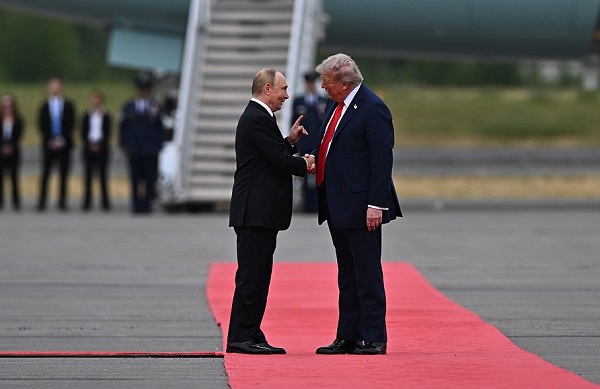.png)

Vijay Singh Chauhan, a former IRS official, is a trade expert, working as Executive Director with Deloitte Touche Tohmatsu India* and Senior Visiting Fellow at Isaac Centre for Public Policy, Ashoka University.
August 18, 2025 at 7:28 AM IST
It was a long weekend in India, which gave many of us time to track the furious pace of developments in the US. Over the past week, Washington has turned the trade and tariff screw on multiple fronts.
The Trump–Putin meeting in Alaska, which, in Trump-speak, was “successful” simply because it lasted longer than a few minutes, was closely watched in both Ukraine and India—two countries with high stakes in its outcome. While experts are not unanimous on the impact of the Ukraine-Russia war, the meeting has increased the likelihood that the proposed 25% secondary tariff on India will either not be imposed or at least be deferred beyond August 27, 2025. One factor working in India’s favour: reports of a voluntary decline in purchases of Russian Ural oil, driven by shrinking margins between Ural and Brent crude now down to about $5 a barrel from a peak of about $30 in 2022.
Legal Wrangles vs. Tariff Power
Meanwhile, the US administration is trying hard to prevent the Federal Circuit from striking down reciprocal tariffs imposed under the International Emergency Economic Powers Act. Many expect the court to uphold the earlier ruling of the Court of International Trade, which had invalidated IEEPA tariffs. They find the government motion submitted to the Federal Circuit low on legal legs and high on its political necessity, arguing that lifting of IEEPA tariffs immediately would “hamstring” the US’s ability to conduct foreign policy and address transnational threats. An adverse ruling would push the matter to the US Supreme Court.
But no such legal cloud hangs over sector-specific tariffs under Section 232 of the Trade Expansion Act, 1962. Last week, Washington expanded the steel and aluminium derivatives list, with new duties effective August 18, 2025. These include a general tariff of 50% on the steel or aluminium content in products. Interestingly, of all the countries that have recently struck trade deals with the US, only the UK has managed to negotiate lower Section 232 tariffs.
Similarly, there appears to be no legal cloud on actions taken under section 301 of the Trade Act, 1974. While some measures, including product-specific tariff investigations by the US Trade Representatives, are underway, fees on Chinese-owned, Chinese-operated, and Chinese-built ships have already been imposed; more measures under this provision are expected.
End of De Minimis Window
Another major move was the detailed rollout of rules ending the de minimis provision, which had allowed duty-free imports of consignments worth under $800 per person per day. From August 29, 2025, even small parcels will attract duties: for exports from India, there would be an option to pay either a 25% tariff or a flat $160 per package, rising to $200 if reciprocal tariffs double. With the responsibility for collection and remittance falling on carriers, the e-commerce industry faces a seismic shift.
The impact could be large. Duty-free shipments to the US soared from 134 million consignments in 2015 to over 1.36 billion in 2024. Now, India’s small consignments will face the same fate as Chinese goods, where withdrawal of de minimis earlier this year forced e-commerce giant Temu to overhaul its model, recruiting US sellers, consolidating orders, and shifting to sea freight. With Indian firms being very small, they cannot perhaps copy the Temu playbook.
Dodging Tariffs, CBP Crackdowns
With Washington layering tariffs by commodity and country, attempts to circumvent them were inevitable. The US Customs and Border Protection has already exposed one large case of $400 million in unpaid duties routed through Chinese shell companies in Taiwan, South Korea, Vietnam, and Indonesia—set up specifically to dodge IEEPA tariffs. How quickly the US Customs and Border Protection clamps down on transshipment and origin-masking will decide the effectiveness of these new measures. At the ground level there should be lots of action to watch.
Backlash Abroad
Most governments have chosen not to retaliate, even Beijing has been working on a temporary truce. But resistance is surfacing at the consumer level. In Canada, the Liquor Control Board of Ontario has pulled US-made spirits like Jack Daniel’s, and Ontario’s government scrapped a $100 million contract with Elon Musk’s Starlink. In Europe, a “Boycott USA” movement is gaining traction online and on the streets of Germany and Italy. In Denmark and Sweden, shoppers are pointedly avoiding US goods in protest against Washington’s trade tactics. In India too calls for “Buy Indian” are growing again.
Inflation Without Fear
Within the US, the fallout is mixed. Inflation is expected to rise by 1.8% in the short term, though shortages haven’t yet materialised. For now, bond and equity markets remain calm, giving the President leeway to wield tariffs and US market access as a strategic weapon. For the rest of the world, it’s wait-and-watch, hoping Washington’s tariff binge doesn’t turn into a lasting trade hangover.
*Views are personal




